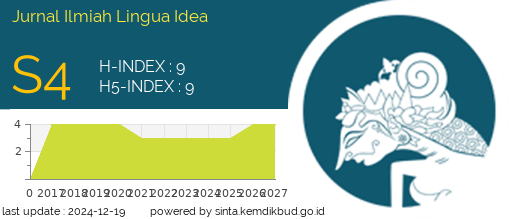Intercultural Awareness Through Indonesian Gastronomy with European Flavours in The Midst of Plurilingualism Political Framework
Abstract
In the midst of a multicultural society, cultivating intercultural awareness is a part of the political framework of plurilingualism, as European linguistic policy is based on a multilingual phenomenon. Plurilingualism is a renewal of the individual's ability to communicate on paralinguistic and paratextual aspects and develop intercultural skills, likely their cultural roots. This political hegemony unwittingly developed massively before the infiltration of French language in Indonesia through flavour contact in the form of gastro diplomacy. Starting with the European cookery heritage in Indonesia, this study aims to explore the presence of European flavours in culinary development to set up the attitudes of respect and understanding of the uniqueness of language culture based on French language learners. In addition to intercultural communication skills, this term contains nationalism as a political goal of plurilingualism, which ideally can eliminate cultural contestation. Therefore, the research methods are document studies, observations, and questionnaires, which aim to explore the existence of intercultural flavours as a form of cultural contact, authenticate cultural knowledge, build intercultural awareness, and diplomatic efforts from French language didactic. The result is a significant change, increasing interest in learning French, and also the development of national identity through knowledge, skills and behaviour as a part of intercultural awareness with authentic language materials.
References
Anggraeni, P. (2015). Menu Populer Hindia Belanda (1901-1942): Kajian Pengaruh Budaya Eropa Terhadap Kuliner Indonesia. Sejarah Dan Budaya, 9(1), 88–95.
Bourdieu, P. (n.d.). La Distinction Critique sociale du jugement Pierre Bourdieu.
Cholsy, H. (n.d.). Kata serapan bahasa perancis sebagai sebuah distingsi dalam ranah kuliner dan mode di indonesia.
Dadang, S. (2006). État du français en Indonésie :une langue à côté d’une ambiance anglophone. 日本フランス語教育学会, 1, 112–116.
Rahman, F. (2016). Jejak Rasa Nusantara: Sejarah Makanan Indonesia. Gramedia.
Ilie, O. A. (2019). The Intercultural Competence. Developing Effective Intercultural Communication Skills. International Conference KNOWLEDGE-BASED ORGANIZATION, 25(2), 264–268. https://doi.org/10.2478/kbo-2019-0092
Intan, T., Saefullah, N. H., Hasanah, F., & Handayani, V. T. (2020). Le symbolisme dans la gastronomie française et indonésienne : Revue interculturelle. FRANCISOLA, 4(2), 33–44. https://doi.org/10.17509/francisola.v4i2.24205
Juillard, C. (2021). Plurilinguisme. Langage et Société, Hors série(HS1), 267–273. https://doi.org/10.3917/ls.hs01.0268
Karman. (2017). Bahasa dan kekuasaan (Instrumen Simbolik Peraih Kekuasaan Versi Bourdieu). Jurnal Studi Komunikasi dan Media, 21(2), 235–246.
Kellner, D. (2004). 9/11, Spectacles of Terror, and Media Manipulation. Critical Discourse Studies, 1(1), 41–64. https://doi.org/10.1080/17405900410001674515
Kertamuda, F. (n.d.). Konselor dan Kesadaran Budaya (Cultural Awareness).
Liando, N. V. F., & Tatipang, D. P. (2022). English or Indonesian Language? Parents’ Perception Toward Children’s Second Language Learning Context. Jurnal Lingua Idea, 13(1), 61. https://doi.org/10.20884/1.jli.2022.13.1.5749
Liska Afriani, Z. (2019). Peran budaya dalam pemerolehan bahasa asing (Vol. 1, Issue 2). http://ejournal.iainbengkulu.ac.id/index.php/disastra
Mahriyuni. (2020). Pembelajaran Bahasa Prancis Berbasis CECR dalam Konteks Plurilinguaisme Bagi Guru dan Siswa SMA (Vol. 5, Issue September).
Nair, S. (n.d.). French Hegemony in Cuisine and Changing Trends. Retrieved from https://www.academia.edu/36020964/French_Hegemony_in_Cuisine_and_Changing_Trends
North, B. (n.d.). The Common European Framework of Reference: Development, Theoretical and Practical issues. https://www.researchgate.net/publication/251995323
Nugroho, B. S. (2020). American Cultural Imperialism in 1960s Japan as Seen in Haruki Murakami’s Norwegian Wood. Jurnal Lingua Idea, 11(1), 1. https://doi.org/10.20884/1.jli.2020.11.1.2361
Savski, K (2002). CEFR as Language policy: Opportunities and Challenges for Local Agency in a Global Era. 50(2021), 60–70.
Septiana, H., Nugroho, H. A., Ardiyanti, W. N., Mael, M. R., & Ridwan, A. (2021). Survival Book to Help BIPA Learners Off the Hook of Culture Shock. Jurnal Lingua Idea, 12(2), 145. https://doi.org/10.20884/1.jli.2021.12.2.4915
Stein-Smith, K. (2017). Foreign Languages: A World of Possibilities. In International Journal of Language and Linguistics (Vol. 4, Issue 4). www.ijllnet.com
Sugiyono. (2018). Metode Penelitian Kuantitatif, Kualitatif, dan R&D. Alfabeta.
Travel Olivier. (n.d.). The Best Food Festival in France. Travel Journal.
Tremblay, C. (2015). Qu’est-ce que le plurilinguisme ? Observatoire Du Plurilinguisme, February, 1–19. https://www.observatoireplurilinguisme.eu/images/Mes_articles/Quest-ce_que_le_plurilinguismeV2.pdf
Walliman, N. (2021). Research Methods The Basics. Routledge.
Wunderle, W. D. (n.d.). Through the Lens of Cultural Awareness: A Primer for US Armed Forces Deploying to Arab and Middle Eastern Countries.

This work is licensed under a Creative Commons Attribution-ShareAlike 4.0 International License.
Authors who publish with Jurnal Ilmiah Lingua Idea agree to the following terms:
- Authors retain copyright and grant the journal right of first publication with the work simultaneously licensed under a Creative Commons Attribution License (CC BY-SA 4.0) that allows others to share the work with an acknowledgment of the work's authorship and initial publication in this journal.
- Authors are able to enter into separate, additional contractual arrangements for the non-exclusive distribution of the journal's published version of the work (e.g., post it to an institutional repository or publish it in a book), with an acknowledgment of its initial publication in this journal.
- Authors are permitted and encouraged to post their work online (e.g., in institutional repositories or on their website) prior to and during the submission process, as it can lead to productive exchanges, as well as earlier and greater citation of published work.





















.png)




_.png)


